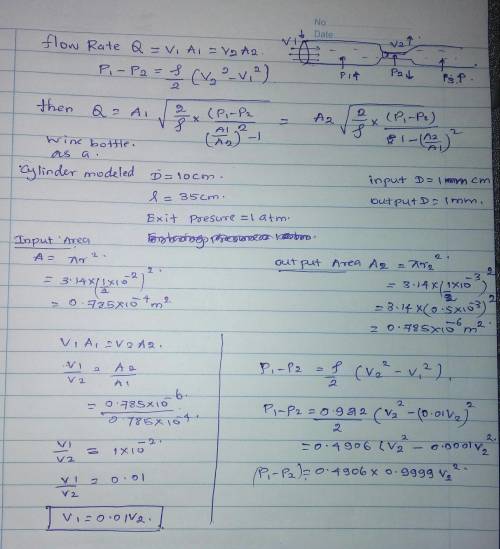
Engineering, 30.03.2020 19:13 ella8586
A wine aerator is a small, in-bottle, hand-held pour-through or decantor top device using the venturi effect for aerating the wine. These devices mix air into the wine as it flows through (or over), increasing exposure to oxygen and causing aeration. Apparently, wine which has been aerated tastes better. You want to design a new aerator that will also chill the wine as it is poured. This aerator will be aventuri-shaped tube with an input diameter of 1 cm and an output diameter of 1 mm. Determine the flow rate of the wine exiting theventure tube while pouring as a function of pouring angle and volume of wine in the bottle. The wine bottle can be modeled as a cylinder of 10 cm in diameter and length of 35 cm. You can assume the pressure at the exit is 1 atm and you can assume the head in the bottle while pouring has a pressure of 1 atm. You will need to determine the pressure at the inlet of the aerator as a function of time at various angles. Assume the bottle starts full. Also, calculate the resultant force needed to keep the device attached to the top of your wine bottle as a function of time for the same angles. Comment on maximum forces. Finally, you need to determine the rate that energy needs to be removed to chill the wine from room temperature to 4 C as it flows through the aerator.

Answers: 2
Another question on Engineering

Engineering, 03.07.2019 19:30
When using the ohmmeter function of a digital multimeter, the leads are placed in what position relative to the component being tested? a. parallel b. control c. series d. line
Answers: 3

Engineering, 04.07.2019 18:10
An air conditioning system consist of a 5 cm diameter pipe, operating at a pressure of 200 kpa. the air initially enters the pipe at 15°c with a velocity of 20 m/s and relative humidity of 80%. if the heat supply throughout the process is 960 w, determine the relative humidity and the temperature at the outlet
Answers: 3

Engineering, 04.07.2019 18:10
Hydraulic fluid with a sg. of 0.78 is flowing through a 1.5 in. i.d. pipe at 58 gal/min. the fluid has an absolute viscosity of 11.8 x 105 lbf-sec/ft2. is the flow laminar, turbulent or within the critical range? give both a numerical reynolds number and a term answer.
Answers: 3

Engineering, 04.07.2019 18:10
Awall of 0.5m thickness is to be constructed from a material which has average thermal conductivity of 1.4 w/mk. the wall is to be insulated with a material having an average thermal conductivity of 0.35 w/mk so that heat loss per square meter shall not exceed 1450 w. assume inner wall surface temperature of 1200°c and outer surface temperature of the insulation to be 15°c. calculate the thickness of insulation required.
Answers: 3
You know the right answer?
A wine aerator is a small, in-bottle, hand-held pour-through or decantor top device using the ventur...
Questions

Mathematics, 27.08.2020 18:01


Social Studies, 27.08.2020 18:01






Health, 27.08.2020 18:01

Mathematics, 27.08.2020 18:01


Biology, 27.08.2020 18:01


History, 27.08.2020 18:01


Biology, 27.08.2020 18:01


Arts, 27.08.2020 18:01





